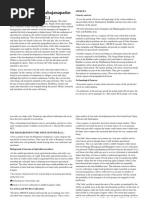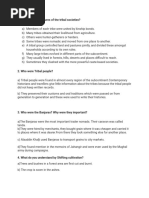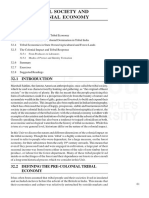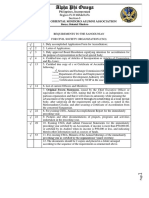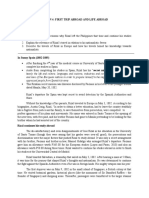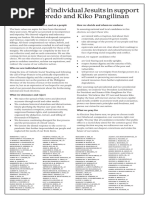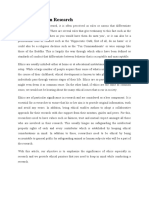Class 7 Social Science Chapter 5 Tribes Nomads and Settled Communities
Class 7 Social Science Chapter 5 Tribes Nomads and Settled Communities
Uploaded by
bobphacultyCopyright:
Available Formats
Class 7 Social Science Chapter 5 Tribes Nomads and Settled Communities
Class 7 Social Science Chapter 5 Tribes Nomads and Settled Communities
Uploaded by
bobphacultyOriginal Description:
Copyright
Available Formats
Share this document
Did you find this document useful?
Is this content inappropriate?
Copyright:
Available Formats
Class 7 Social Science Chapter 5 Tribes Nomads and Settled Communities
Class 7 Social Science Chapter 5 Tribes Nomads and Settled Communities
Uploaded by
bobphacultyCopyright:
Available Formats
5 Tribes, Nomads and
Settled Communities
Y ou saw in Chapters 2, 3 and 4 how kingdoms
rose and fell. Even as this was happening, new arts,
crafts and production activities flourished in towns
and villages. Over the centuries important political, Fig. 1
social and economic developments had taken place. Tribal dance,
But social change was not the same everywhere, Santal painted scroll.
because different kinds of societies evolved
differently. It is important to understand
how and why this happened.
In large parts of the subcontinent, society
was already divided according to the rules
of varna. These rules, as prescribed by the
Brahmanas, were accepted by the rulers
of large kingdoms. The difference between
the high and low, and between the rich and
poor, increased. Under the Delhi Sultans
and the Mughals, this hierarchy between
social classes grew further.
Beyond Big Cities: Tribal
Societies
There were, however, other kinds of
societies as well. Many societies in the
subcontinent did not follow the social rules
and rituals prescribed by the Brahmanas.
Nor were they divided into numerous
unequal classes. Such societies are often
called tribes.
tribes, nomads and
49 settled communities
Rationalised 2023-24
Unit 5 to 7.indd 49 8/25/2022 12:23:00 PM
Members of each tribe were united by kinship
bonds. Many tribes obtained their livelihood from
agriculture. Others were hunter-gatherers or herders.
Most often they combined these activities to make
full use of the natural resources of the area in which
they lived. Some tribes were nomadic and moved
from one place to another. A tribal group controlled
land and pastures jointly, and divided these amongst
households according to its own rules.
? Many large tribes thrived in different parts of the
On a physical
subcontinent. They usually lived in forests, hills,
map of the
deserts and places difficult to reach. Sometimes they
subcontinent,
identify the areas clashed with the more powerful caste-based societies.
in which tribal In various ways, the tribes retained their freedom and
people may have preserved their separate culture.
lived. But the caste-based and tribal societies also
depended on each other for their diverse needs. This
relationship, of conflict and dependence, gradually
caused both societies to change.
Who were Tribal People?
Contemporary historians and travellers give very
scanty information about tribes. A few exceptions
apart, tribal people did not keep written records. But
they preserved rich customs and oral traditions. These
were passed down to each new generation. Present-
day historians have started using such oral traditions
to write tribal histories.
Tribal people were found in almost every region of
the subcontinent. The area and influence of a tribe
varied at different points of time. Some powerful tribes
controlled large territories. In Punjab, the Khokhar
tribe was very influential during the thirteenth and
fourteenth centuries. Later, the Gakkhars became
more important. Their chief, Kamal Khan Gakkhar,
was made a noble (mansabdar) by Emperor Akbar. In
Multan and Sind, the Langahs and Arghuns dominated
extensive regions before they were subdued by the
Mughals. The Balochis were another large and powerful
our pasts – ii 50
Rationalised 2023-24
Unit 5 to 7.indd 50 17-05-2022 12:16:14
Map 1
Location of some
of the major Indian
tribes.
tribe in the north-west. They were divided into many
smaller clans under different chiefs. In the western Clan
Himalaya lived the shepherd tribe of Gaddis. The A clan is a group
distant north-eastern part of the subcontinent too was of families or
entirely dominated by tribes – the Nagas, Ahoms and households
many others. claiming descent
from a common
In many areas of present-day Bihar and Jharkhand, ancestor. Tribal
Chero chiefdoms had emerged by the twelfth century. organisation is
Raja Man Singh, Akbar’s famous general, attacked often based on
and defeated the Cheros in 1591. A large amount of kinship or clan
booty was taken from them, but they were not entirely loyalties.
subdued. Under Aurangzeb, Mughal forces captured
many Chero fortresses and subjugated the tribe. The
Mundas and Santals were among the other important
tribes that lived in this region and also in Orissa
and Bengal.
tribes, nomads and
51 settled communities
Rationalised 2023-24
Unit 5 to 7.indd 51 17-05-2022 12:16:15
The Maharashtra highlands and
Karnataka were home to Kolis,
Berads and numerous others.
Kolis also lived in many areas of
Gujarat. Further south there were
large tribal populations of Koragas,
Vetars, Maravars and many others.
The large tribe of Bhils was
spread across western and central
India. By the late sixteenth
century, many of them had
become settled agriculturists and
some even zamindars. Many Bhil
clans, nevertheless, remained
hunter-gatherers. The Gonds were
found in great numbers across the
present-day states of Chhattisgarh,
Madhya Pradesh, Maharashtra and
Andhra Pradesh.
How Nomads and
Mobile People Lived
Nomadic pastoralists moved
over long distances with their
animals. They lived on milk and
other pastoral products. They also
exchanged wool, ghee, etc., with
settled agriculturists for grain,
cloth, utensils and other products.
Fig. 2
Bhils hunting deer by night.
Fig.3
A chain of mobile traders connected
India to the outside world. Here you see
nuts being gathered and loaded on the
backs of camels. Central Asian traders
brought such goods to India and the
Banjaras and other traders carried
these to local markets.
our pasts – ii 52
Rationalised 2023-24
Unit 5 to 7.indd 52 17-05-2022 12:16:17
They bought and sold these goods as they moved
from one place to another, transporting them on their Nomads and
animals. itinerant groups
The Banjaras were the most important trader- Nomads are
nomads. Their caravan was called tanda. Sultan wandering people.
Many of them
Alauddin Khalji (Chapter 3) used the Banjaras to
are pastoralists
transport grain to the city markets. Emperor Jahangir
who roam from
wrote in his memoirs that the Banjaras carried grain one pasture to
on their bullocks from different areas and sold it in another with their
towns. They transported food grain for the Mughal flocks and herds.
army during military campaigns. With a large army Similarly, itinerant
there could be 100,000 bullocks carrying grain. groups, such as
craftspersons,
pedlars and
entertainers travel
The Banjaras
from place to
Peter Mundy, an English trader who came to India place practising
during the early seventeenth century, has described their different
the Banjaras: occupations.
Both nomads and
In the morning we met a tanda of Banjaras with 14,000 itinerant groups
oxen. They were all laden with grains such as wheat and often visit the
rice ... These Banjaras carry their household – wives and same places every
children – along with them. One tanda consists of many year.
families. Their way of life is similar to that of carriers who
continuously travel from place to place. They own their oxen.
They are sometimes hired by merchants, but most commonly
they are themselves merchants. They buy grain where it is
cheaply available and carry it to places where it is dearer.
From there, they again reload their oxen with anything that
can be profitably sold in other places … In a tanda there may
be as many as 6 or 7 hundred persons … They do not travel
more than 6 or 7 miles a day – that, too, in the cool weather.
After unloading their oxen, they turn them free to graze as
there is enough land here, and no one there to forbid them.
Find out how grain is transported from villages
? to cities at present. In what ways is this similar
to or different from the ways in which the
Banjaras functioned?
tribes, nomads and
53 settled communities
Rationalised 2023-24
Unit 5 to 7.indd 53 17-05-2022 12:16:18
Many pastoral tribes reared and sold animals,
such as cattle and horses, to the prosperous people.
Different castes of petty pedlars
also travelled from village to
village. They made and
sold wares such as ropes,
reeds, straw matting and
coarse sacks. Sometimes
mendicants acted as
wandering merchants. There
Fig. 4
Bronze crocodile,
were castes of entertainers who performed in different
Kutiya Kond tribe, towns and villages for their livelihood.
Orissa.
Changing Society: New Castes and
Hierarchies
As the economy and the needs of society grew, people
with new skills were required. Smaller castes, or
jatis, emerged within varnas. For example, new castes
appeared amongst the Brahmanas. On the other
hand, many tribes and social groups were taken
into caste-based society and given the status of
jatis. Specialised artisans – smiths, carpenters and
masons – were also recognised as separate jatis by
the Brahmanas. Jatis, rather than varna, became the
basis for organising society.
Deliberations on jati
A twelfth-century inscription from Uyyakondan Udaiyar,
in Tiruchirapalli taluka (in present-day Tamil Nadu),
describes the deliberations in a sabha (Chapter 2) of
Brahmanas.
They deliberated on the status of a group known as
rathakaras (literally, chariot makers). They laid down
their occupations, which were to include architecture,
building coaches and chariots, erecting gateways
for temples with images in them, preparing wooden
equipment used to perform sacrifices, building
mandapas, making jewels for the king.
our pasts – ii 54
Rationalised 2023-24
Unit 5 to 7.indd 54 17-05-2022 12:16:19
Among the Kshatriyas, new Rajput clans became
powerful by the eleventh and twelfth centuries.
They belonged to different lineages, such as Hunas,
Chandelas, Chalukyas and others. Some of these, too,
had been tribes earlier. Many of these clans came to
be regarded as Rajputs. They gradually replaced the
older rulers, especially in agricultural areas. Here a
developed society was emerging, and rulers used their
wealth to create powerful states.
The rise of Rajput clans to the position of rulers set
an example for the tribal people to follow. Gradually,
with the support of the Brahmanas, many tribes
became a part of the caste system. But only the leading
tribal families could join the ruling class. A large
majority joined the lower jatis of caste society. On the
other hand, many dominant tribes of Punjab, Sind and
the North-West Frontier had adopted Islam quite early.
They continued to reject the caste system. The unequal
social order, prescribed by orthodox Hinduism, was
not widely accepted in these areas.
The emergence of states is closely related to social
change amongst tribal people. Two examples of this Fig. 5
important part of our history are described below. A Gond woman.
A Closer Look Shifting
The Gonds cultivation
Trees and bushes
The Gonds lived in a vast forested region called in a forest area
Gondwana – or “country inhabited by Gonds”. They are first cut and
practised shifting cultivation. The large Gond tribe burnt. The crop
was further divided into many smaller clans. Each clan is sown in the
had its own raja or rai. About the time that the power ashes. When this
of the Delhi Sultans was declining, a few large Gond land loses its
kingdoms were beginning to dominate the smaller fertility, another
Gond chiefs. The Akbar Nama, a history of Akbar’s plot of land is
reign, mentions the Gond kingdom of Garha Katanga cleared and
that had 70,000 villages. planted in the
same way.
The administrative system of these kingdoms was
becoming centralised. The kingdom was divided into
tribes, nomads and
55 settled communities
Rationalised 2023-24
Unit 5 to 7.indd 55 17-05-2022 12:16:19
garhs. Each garh was controlled
by a particular Gond clan. This
was further divided into units of
84 villages called chaurasi. The
chaurasi was subdivided into
barhots which were made up of
12 villages each.
The emergence of large states
changed the nature of Gond
society. Their basically equal
society gradually got divided
into unequal social classes.
Brahmanas received land grants
from the Gond rajas and became
more influential. The Gond chiefs
now wished to be recognised
as Rajputs. So, Aman Das, the
Gond raja of Garha Katanga,
assumed the title of Sangram
Map 2 Shah. His son, Dalpat, married
Gondwana. princess Durgawati, the daughter
of Salbahan, the Chandel
Rajput raja of Mahoba.
Dalpat, however, died
Fig. 6
early. Rani Durgawati
A carved door.
Gond tribe, Bastar was very capable, and
area, Madhya started ruling on behalf
Pradesh. of her five-year-old son,
Bir Narain. Under her,
the kingdom became
even more extensive. In
1565, the Mughal forces
under Asaf Khan attacked
Garha Katanga. A strong
resistance was put up by
Rani Durgawati. She was
defeated and preferred to
die rather than surrender.
Her son, too, died fighting
soon after.
our pasts – ii 56
Rationalised 2023-24
Unit 5 to 7.indd 56 17-05-2022 12:16:20
Garha Katanga was a rich state. It earned much
wealth by trapping and exporting wild elephants to other
kingdoms. When the Mughals defeated the Gonds, they
?
captured a huge booty of precious coins and elephants. Discuss why the
They annexed part of the kingdom and granted the rest Mughals were
interested in the
to Chandra Shah, an uncle of Bir Narain. Despite the
land of the Gonds.
fall of Garha Katanga, the Gond kingdoms survived for
some time. However, they became much weaker and
later struggled unsuccessfully against the stronger
Bundelas and Marathas.
The Ahoms
The Ahoms migrated to the Brahmaputra valley from
present-day Myanmar in the thirteenth century.
They created a new state by suppressing the older
political system of the bhuiyans (landlords). During
the sixteenth century, they annexed the kingdoms of
the Chhutiyas (1523) and of Koch-Hajo (1581) and
subjugated many other tribes. The Ahoms built a
large state, and for this they used firearms as early as
the 1530s. By the 1660s they could even make high-
quality gunpowder and cannons.
Map 3
However, the Ahoms faced many invasions from the Tribes of eastern
south-west. In 1662, the Mughals under Mir Jumla India.
attacked the Ahom kingdom. Despite their brave
defence, the Ahoms were defeated.
But direct Mughal control over the
region could not last long.
The Ahom state depended upon
forced labour. Those forced to work
for the state were called paiks.
A census of the population was
taken. Each village had to send a
number of paiks by rotation. People
from heavily populated areas were
shifted to less populated places.
Ahom clans were thus broken up.
By the first half of the seventeenth
century the administration became
quite centralised.
tribes, nomads and
57 settled communities
Rationalised 2023-24
Unit 5 to 7.indd 57 17-05-2022 12:16:21
Almost all adult males served in the army during
war. At other times, they were engaged in building
dams, irrigation systems and other public works. The
Ahoms also introduced new methods of rice cultivation.
Ahom society was divided into clans or khels. There
were very few castes of artisans, so artisans in the
Ahom areas came from the adjoining kingdoms. A khel
often controlled several villages. The peasant was given
land by his village community. Even the king could not
Fig. 7 take it away without the community’s consent.
Ear ornaments, Koboi
Naga tribe, Manipur. Originally, the Ahoms worshipped their own tribal
gods. During the first half of the seventeenth century,
however, the influence of Brahmanas increased.
Temples and Brahmanas were granted land by the
king. In the reign of Sib Singh (1714 –1744), Hinduism
became the predominant religion. But the Ahom kings
did not completely give up their traditional beliefs after
adopting Hinduism.
Ahom society was very sophisticated. Poets
and scholars were given land grants. Theatre was
encouraged. Important works of Sanskrit were
translated into the local language. Historical works,
? known as buranjis, were also written – first in the Ahom
language and then in Assamese.
Why do you think
the Mughals
tried to conquer Conclusion
the land of the
Ahoms? Considerable social change took place in the subcontinent
during the period we have been examining. Varna-based
society and tribal people constantly interacted with each
other. This interaction caused both kinds of societies
to adapt and change. There were many different tribes
and they took up diverse livelihoods. Over a period of
time, many of them merged with caste-based society.
Others, however, rejected both the caste system and
orthodox Hinduism. Some tribes established extensive
states with well-organised systems of administration.
They thus became politically powerful. This brought
them into conflict with larger and more complex
kingdoms and empires.
our pasts – ii 58
Rationalised 2023-24
Unit 5 to 7.indd 58 17-05-2022 12:16:21
Imagine
You are a member of a nomadic
community that shifts residence every
three months. How would this change
your life?
Let’s recall Keywords
1. Match the following:
garh khel varna
tanda chaurasi
jati
labourer caravan
clan Garha Katanga tanda
Sib Singh Ahom state garh
Durgawati paik
chaurasi
2. Fill in the blanks:
barhot
(a) The new castes emerging within varnas were bhuiyans
called _____________.
paik
(b) _____________ were historical works written by the
Ahoms. khel
(c) The ____________ mentions that Garha Katanga buranji
had 70,000 villages.
census
(d) As tribal states became bigger and stronger, they
gave land grants to _________ and ________.
3. State whether true or false:
(a) Tribal societies had rich oral traditions.
(b) There were no tribal communities in the north-
western part of the subcontinent.
(c) The chaurasi in Gond states contained several cities.
tribes, nomads and
59 settled communities
Rationalised 2023-24
Unit 5 to 7.indd 59 17-05-2022 12:16:22
(d) The Bhils lived in the north-eastern part of the
subcontinent.
4. What kinds of exchanges took place between nomadic
pastoralists and settled agriculturists?
Let’s understand
5. How was the administration of the Ahom state organised?
6. What changes took place in varna-based society?
7. How did tribal societies change after being organised
into a state?
Let’s discuss
8. Were the Banjaras important for the economy?
9. In what ways was the history of the Gonds different
from that of the Ahoms? Were there any similarities?
Let’s do
10. Plot the location of the tribes mentioned in this chapter
on a map. For any two, discuss whether their mode
of livelihood was suited to the geography and the
environment of the area where they lived.
11. Find out about present-day government policies
towards tribal populations and organise a discussion
about these.
12. Find out more about present-day nomadic pastoral
groups in the subcontinent. What animals do they
keep? Which are the areas frequented by these groups?
our pasts – ii 60
Rationalised 2023-24
Unit 5 to 7.indd 60 17-05-2022 12:16:22
You might also like
- Conversion To Christianity Among The NagasDocument44 pagesConversion To Christianity Among The NagasRaiot Webzine100% (4)
- Unit 4. RevisionDocument8 pagesUnit 4. RevisionNhật Ánh100% (1)
- Gess 105Document12 pagesGess 105MRIDUL GUPTANo ratings yet
- 3. Tribes, Nomads and settled communitiesDocument6 pages3. Tribes, Nomads and settled communitiesranjit15161516No ratings yet
- Tribs NomadsDocument25 pagesTribs NomadsAkbarali Charankav100% (1)
- Class 7 Social Science Tribes Nomads and Settled Communities Exam NotesDocument5 pagesClass 7 Social Science Tribes Nomads and Settled Communities Exam NotesUdayan GeraNo ratings yet
- CH 6 TRIBES, NOMADS AND SETTLED COMMUNITIES- WITH ANSWERS (2)Document5 pagesCH 6 TRIBES, NOMADS AND SETTLED COMMUNITIES- WITH ANSWERS (2)Reeta SinghNo ratings yet
- Population.-According To This ScheduleDocument9 pagesPopulation.-According To This SchedulerutujaNo ratings yet
- Key H-5Document2 pagesKey H-5AbhishekNo ratings yet
- Medieval India Agrarain ExpansionDocument6 pagesMedieval India Agrarain ExpansionHimanshu Thakuria100% (28)
- TribesDocument11 pagesTribesniki8sNo ratings yet
- Unit-37 Transition To Early Medieval IndiaDocument10 pagesUnit-37 Transition To Early Medieval IndiaYashika SinghNo ratings yet
- 5.maha JanapadasDocument21 pages5.maha JanapadasAnup KumarNo ratings yet
- Tribes, Nomads and Settled Communities - ClassnotesDocument30 pagesTribes, Nomads and Settled Communities - ClassnoteschesstamojitNo ratings yet
- Class VII Social Science (History) Notes Chapter 5 Tribes Nomads and Settled CommunitiesDocument43 pagesClass VII Social Science (History) Notes Chapter 5 Tribes Nomads and Settled CommunitiesArtham ResourcesNo ratings yet
- Indian History About TribesDocument3 pagesIndian History About TribesalvinkalexjosephNo ratings yet
- Land System in IndiaDocument8 pagesLand System in IndiaShubham RawatNo ratings yet
- UPSC Wallah Books Ancient India 21Document2 pagesUPSC Wallah Books Ancient India 21terre veere di clipNo ratings yet
- 5 6152470377265102995Document8 pages5 6152470377265102995Mohammed ShamsuddinNo ratings yet
- Traditional Hill Tribes of ManipurDocument2 pagesTraditional Hill Tribes of Manipurmeiteileibak2No ratings yet
- Social Life: The Brahmanical OrderDocument14 pagesSocial Life: The Brahmanical OrderAnjana SinghNo ratings yet
- Chapter 7 Tribes Nomads and Settle CommunitiesDocument3 pagesChapter 7 Tribes Nomads and Settle CommunitiesGaming ApocalypseNo ratings yet
- American Oriental Society Journal of The American Oriental SocietyDocument12 pagesAmerican Oriental Society Journal of The American Oriental SocietyankitNo ratings yet
- Pre Islam MeccaDocument8 pagesPre Islam MeccaAbutalib123No ratings yet
- 20241216160320_iis_w_Tribes_Nomads_and_Settled_Communities-NotesDocument2 pages20241216160320_iis_w_Tribes_Nomads_and_Settled_Communities-Notesar.mohammedabedNo ratings yet
- Class 7 History - Tribal SocietyDocument6 pagesClass 7 History - Tribal SocietyAshNo ratings yet
- 956am - 6.EPRA JOURNALS 9285Document4 pages956am - 6.EPRA JOURNALS 9285Keith HuntNo ratings yet
- Ch-5 Tribes, Nomads and Settled CommunitieaasDocument3 pagesCh-5 Tribes, Nomads and Settled Communitieaassinghpriti442011No ratings yet
- Varna Jati and Brahmanisation.Document6 pagesVarna Jati and Brahmanisation.Rishabh SolankiNo ratings yet
- Unit 16Document8 pagesUnit 16saqueeb111No ratings yet
- HistoryDocument5 pagesHistorymr.ankit121lalNo ratings yet
- AS_WB_CB_VII_SSC_Tribes and Tribal Societies in Medival IndiaDocument6 pagesAS_WB_CB_VII_SSC_Tribes and Tribal Societies in Medival IndiadivyaNo ratings yet
- Medieval SocietyDocument5 pagesMedieval SocietyGauravNo ratings yet
- MN Srinivas Obituary Caste - Handout 37Document5 pagesMN Srinivas Obituary Caste - Handout 37naveen2612sharmaNo ratings yet
- Unit-32Document10 pagesUnit-32Vinod SinghNo ratings yet
- History Chap-7Document3 pagesHistory Chap-7itzspooky07No ratings yet
- Ncert - SST - Ak 7Document126 pagesNcert - SST - Ak 7Karthi KeyanNo ratings yet
- Adobe Scan 04 Apr 2024 (1)Document6 pagesAdobe Scan 04 Apr 2024 (1)Riya SenNo ratings yet
- An Obituary On Caste As A SystemDocument5 pagesAn Obituary On Caste As A SystemAparajay SurnamelessNo ratings yet
- 13th and 14th Century SocietiesDocument6 pages13th and 14th Century SocietiesAnuraj TirthankarNo ratings yet
- UPSC Wallah Books Ancient India 29Document2 pagesUPSC Wallah Books Ancient India 29terre veere di clipNo ratings yet
- The Myth of Selfsufficiency of The Indian VillageDocument4 pagesThe Myth of Selfsufficiency of The Indian Villageparallel spaceNo ratings yet
- Unit 0 Study NotesDocument17 pagesUnit 0 Study Notesfanilu097No ratings yet
- Tribes, Nomads and Settled Communities Class 7 Notes CBSE History Chapter 7 PDFDocument4 pagesTribes, Nomads and Settled Communities Class 7 Notes CBSE History Chapter 7 PDFvaradharajharshitha0No ratings yet
- E-book Anskey History 7 CH 7Document3 pagesE-book Anskey History 7 CH 7stxaviers234No ratings yet
- Unit-12 Early Medieval Economy and Its ContinuitiesDocument16 pagesUnit-12 Early Medieval Economy and Its ContinuitiesEmre HpNo ratings yet
- 196174216674_10152149193986675 (1)Document258 pages196174216674_10152149193986675 (1)Narshing KoliNo ratings yet
- .A Study On Causes and Impact On Land Alienation of Tribal Community Living in HD Kote, Mysuru District KarnatakaDocument4 pages.A Study On Causes and Impact On Land Alienation of Tribal Community Living in HD Kote, Mysuru District Karnatakamangesh khamkarNo ratings yet
- Ehi 3 emDocument9 pagesEhi 3 emamazonpoint24No ratings yet
- L-26 Indian Society Tribal Rural and UrbanDocument14 pagesL-26 Indian Society Tribal Rural and Urbanpraneeth_rd50% (2)
- This Content Downloaded From 3.7.228.102 On Fri, 14 Jan 2022 21:07:24 UTCDocument12 pagesThis Content Downloaded From 3.7.228.102 On Fri, 14 Jan 2022 21:07:24 UTCAliveNo ratings yet
- Tribes, Nomads and Settled Communties HandoutDocument3 pagesTribes, Nomads and Settled Communties Handoutgoyalaarush0No ratings yet
- Caste Question Indian Democratic Revolution ANURADHA GANDHIDocument76 pagesCaste Question Indian Democratic Revolution ANURADHA GANDHIAby K GeorgeNo ratings yet
- The Art of Not Being Governed PDFDocument33 pagesThe Art of Not Being Governed PDFSilvia Gomes100% (2)
- Unit-16 Alternative Social FormationsDocument18 pagesUnit-16 Alternative Social FormationssaithimranadnanNo ratings yet
- DOC-20241226-WA0000Document7 pagesDOC-20241226-WA0000shaikrahim588No ratings yet
- Slide 12Document6 pagesSlide 12rohitvermashakyaNo ratings yet
- Unit 32Document14 pagesUnit 32Jigyasa SinghalNo ratings yet
- History Handout 2Document31 pagesHistory Handout 2Gagandeep KumarNo ratings yet
- Historical Development of Thanjavur Kisan MovementDocument9 pagesHistorical Development of Thanjavur Kisan MovementgowthamNo ratings yet
- EJ1125725Document20 pagesEJ1125725bobphacultyNo ratings yet
- Saudi Arabia Real Estate Market Review Q3 2023Document8 pagesSaudi Arabia Real Estate Market Review Q3 2023bobphacultyNo ratings yet
- Scalable Bias-Resistant Distributed RandomnessDocument17 pagesScalable Bias-Resistant Distributed RandomnessbobphacultyNo ratings yet
- Basic Academic Research Plan TemplateDocument20 pagesBasic Academic Research Plan TemplatebobphacultyNo ratings yet
- State of The Art in Surface Reconstruction From Point CloudsDocument25 pagesState of The Art in Surface Reconstruction From Point CloudsbobphacultyNo ratings yet
- InequalityDocument2 pagesInequalityhuzaifa12340786No ratings yet
- Requirements To The SanggunianDocument53 pagesRequirements To The SanggunianWindel PermalinoNo ratings yet
- Ethonocentrism and Cutural RelativismDocument18 pagesEthonocentrism and Cutural RelativismLobzang DorjiNo ratings yet
- Rooster Nombres Lapd y EtniasDocument217 pagesRooster Nombres Lapd y EtniaslspdaudiovisualhandbookNo ratings yet
- Moral Mazes by Robert JackallDocument309 pagesMoral Mazes by Robert Jackallhibberts.arisNo ratings yet
- American Futurist Manifesto: Alexander SlavrosDocument7 pagesAmerican Futurist Manifesto: Alexander SlavrosAlfredHugenbergNo ratings yet
- The Plight of Women in "From A Crooked Rib" by Nuruddin FarahDocument3 pagesThe Plight of Women in "From A Crooked Rib" by Nuruddin FarahzyleflorenceNo ratings yet
- Barry (2005)Document43 pagesBarry (2005)shaun.stephen.yates1991No ratings yet
- Biometric - 2024Document3 pagesBiometric - 2024mdmonowerislam318No ratings yet
- UCSP Q2 Module 9 Concept Characteristics and Forms of Social StratificationDocument21 pagesUCSP Q2 Module 9 Concept Characteristics and Forms of Social StratificationAngel Picazo75% (4)
- Lesson 4: First Trip Abroad and Life AbroadDocument8 pagesLesson 4: First Trip Abroad and Life AbroadheyyoggggNo ratings yet
- Orphan GirlDocument4 pagesOrphan GirlRaj ShenoyNo ratings yet
- Introduction To Business EthicsDocument13 pagesIntroduction To Business EthicsChristine Ramil EugenioNo ratings yet
- Kyla SimmonsDocument14 pagesKyla SimmonsKyla SimmonsNo ratings yet
- Manoj Kumar Sustainable Development IJCRT2312701Document8 pagesManoj Kumar Sustainable Development IJCRT2312701anshgoyal226No ratings yet
- This Discussion of Commercial ActivitiesDocument23 pagesThis Discussion of Commercial Activitiesrmaspikey88No ratings yet
- CALAMBA INTEGRATED SCHOOL The Problem AnDocument20 pagesCALAMBA INTEGRATED SCHOOL The Problem AnCute AkoNo ratings yet
- Western MapleDocument7 pagesWestern MapleVladimir TarasenkoNo ratings yet
- Five Pillars of Education Infographic - Arjay SantiagoDocument1 pageFive Pillars of Education Infographic - Arjay Santiagoarjay.santiagoNo ratings yet
- Pride and Prejudice PDFDocument264 pagesPride and Prejudice PDFLiving WordsNo ratings yet
- Jesuit Statement INQ BW AD v2Document1 pageJesuit Statement INQ BW AD v2Ali FigueroaNo ratings yet
- Comparative Analysis Between Marriage Needs of - Millennial' and Baby Boomers RRLDocument4 pagesComparative Analysis Between Marriage Needs of - Millennial' and Baby Boomers RRLChrisse Josephinee A. RedNo ratings yet
- Ed 101 Application No.2Document2 pagesEd 101 Application No.2Kenneth HerreraNo ratings yet
- Practice Test 7Document6 pagesPractice Test 7Quang HuyyNo ratings yet
- Solidarity Statement Against IT SearchesDocument20 pagesSolidarity Statement Against IT SearchesThe WireNo ratings yet
- Role of Ethics in ResearchDocument3 pagesRole of Ethics in ResearchDiana Wangamati100% (1)
- Đề Số 32 Có Giải Chi TiếtDocument18 pagesĐề Số 32 Có Giải Chi TiếtNguyên HoàngNo ratings yet
- BRIEF - HISTORY - GAY Mag CanadaDocument98 pagesBRIEF - HISTORY - GAY Mag CanadaJurdiney JuniorNo ratings yet
- Old EnglishDocument3 pagesOld EnglishAbtahee HazzazNo ratings yet












